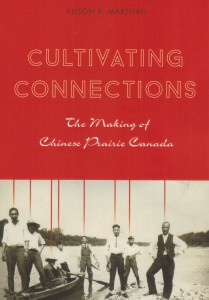There is an urban myth in Moose Jaw, Sask. that local Chinese built subterranean opium dens where gawd knows what went on. Local tour operators sell tickets to see the tunnels. Did Chinese drug fiends dig them? “Some may have worked and lived in these spaces to avoid prosecution,” says one titillating website.
Not exactly.
When Professor Allison Marshall of Brandon University set out to compile her intriguing social history of Chinese migration on the Prairies, she notes local gossips kept bringing up the opium dens of Moose Jaw. “Even to this day, the city perpetuates images of Chinese who dwelled underground in tunnels and lived the life of heathens in opium dens, laundries and gambling joints,” writes Marshall.
“None of my research participants had much involvement with Moose Jaw, though non-Chinese participants were quick to try to steer me there,” adds Marshall. “Urban myths circulated that there were also tunnels in Winnipeg’s Chinatown; however, this is untrue.”
The truth is much better.
Cultivating Connections is a warm, human account of the extraordinary lives of Chinese who settled on the Prairies in pre-war years. The community was so prosperous the Young Men’s Chinese Christian Association had clubs in Winnipeg, Edmonton and Calgary; in 1912 the Chinese Nationalist League, the Kuomintang, operated branches from Brandon to Saskatoon. Sun Yat-Sen, founder of the Chinese republic, visited Canada three times between 1897 and 1911.
“Chinese experienced pervasive racism on the Prairies,” writes Marshall, but notes the most biting bigotry came at the hands of officialdom, not the neighbours. In Saskatchewan, provincial law forbade Chinese café owners from hiring Caucasian waitresses for fear of “white slavery.” It was an Act of Parliament in 1923 that made it virtually impossible for Chinese-Canadian men to sponsor their own wives and children as immigrants.
“Brothels and prostitution rings operated in the mid- to late-1800s by American Chinese gangs known as tongs helped perpetuate the false perception that all Chinese women were prostitutes and that Chinese men were corrupt opium merchants or dirty labourers,” says Cultivating Connections.
Yet Marshall’s account of Chinese settlement is more vivid than a simple recitation of colonial intolerance. When Winnipeg’s KMT Chinese community applied for a Parks Board permit to hold a picnic and sports day in 1918 the request was denied — not because they were Chinese, but because the Lord’s Day Act forbade sports on a Sunday. A Saturday permit was promptly granted.
When a Chinese team won a 1918 soccer championship, the Dingwall Cup, The Manitoba Free Press reported: “Contrary to expectations, it was a real game that the Chinks put up, their playing being of a surprisingly high-class order, and their teamwork well-nigh perfect.”
Marshall documents the lives of these pioneers through meticulous research and fresh interviews. She recounts Chinese night schools where first-generation children were dispatched to study calligraphy and the wisdom of sages. “I never did learn a damn thing,” one old-timer recalled. “Those were long days as kids”.
If Chinese settlers were subjected to unfair taxes, pernicious laws and crude stereotypes, they were admired too by fellow Prairie people who struggled to make their own way. Marshall recounts the poignant story of Happy Young, for thirty years the proprietor of the Canada Café in Esterhazy, Sask.
When Young retired in 1950 the Esterhazy Observer praised him as “a beloved citizen of this community” and longtime sponsor of the junior hockey team. Writes Marshall: “As a Saskatchewan-based Chinese merchant Happy did not have full legal rights. But to his patrons and friends he had become a beloved citizen.”
Young died in 1956 and is buried in Brandon. On Qingming, the annual Chinese observance of tomb sweeping day, Professor Marshall paid a visit: “I thanked Happy by making offerings at his grave.”
By Holly Doan
Cultivating Connections: The Making Of Chinese Prairie Canada, by Alison Marshall; University of British Columbia Press; 288 pages; ISBN 9780-7748-28017; $32.95






